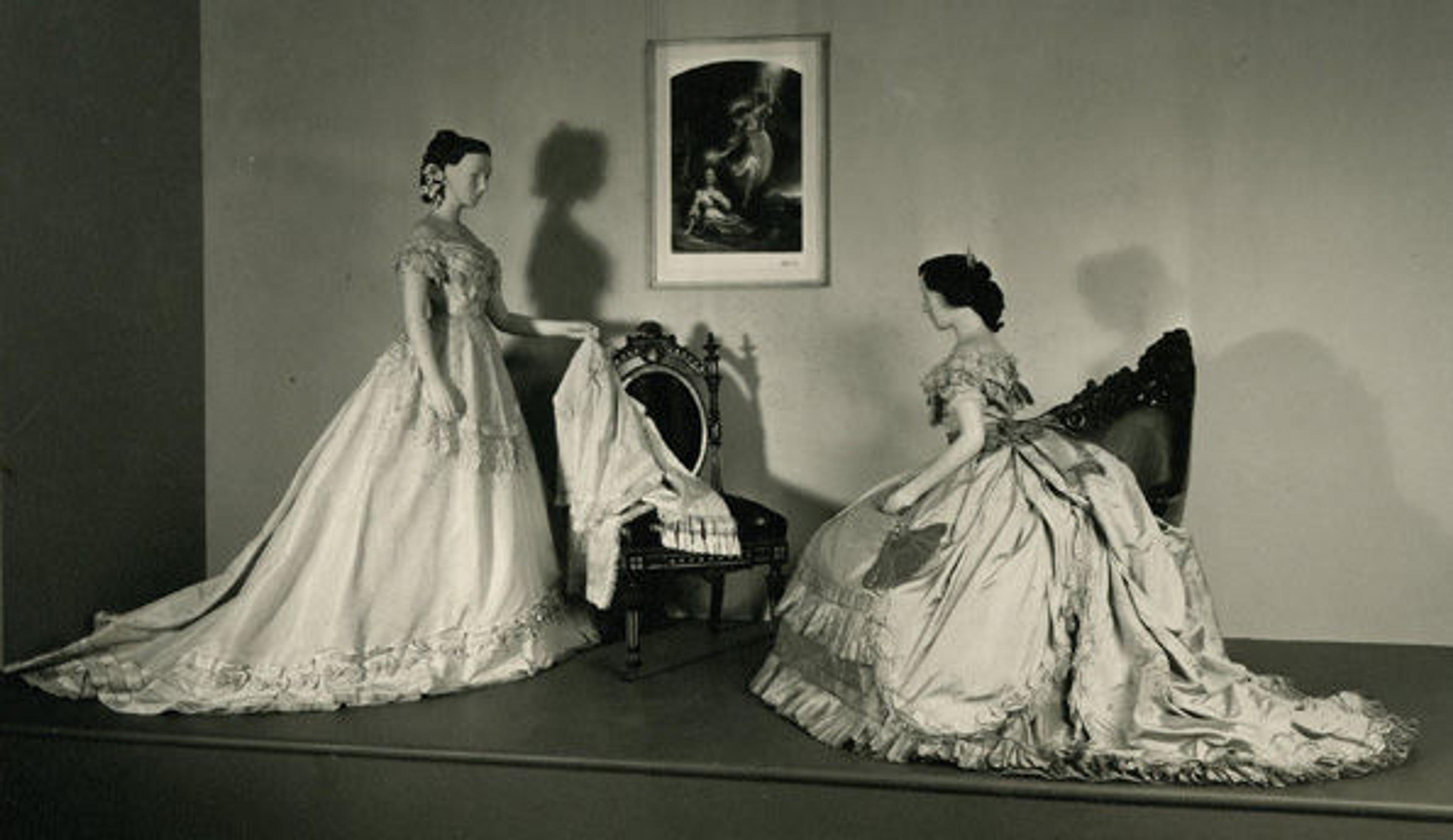«Sixty-five years ago today, on December 13, 1946, The Costume Institute's first exhibition at the Metropolitan Museum opened to the public.»
Photograph from a section of the exhibition entitled "1867–1870: Flamboyant Lines." Costume Institute Records.
Arranged by Polaire Weissman, executive director of The Costume Institute from 1937 to 1969, the exhibition displayed fashions from the third quarter of the eighteenth century through the end of the nineteenth century. The exhibition's nine tableaux featured forty-nine costumes drawn from The Costume Institute's collection, and each tableau was decorated with furniture and accessories from the Museum's collection and the Museum of the City of New York. Other Costume Institute facilities, including a newly installed textile study room, were also open to the public on this special occasion.
These two pieces, visible in the exhibition photograph above, as they appear on the Museum's website today. Left: Dress, Evening, ca. 1867. French. The Metropolitan Museum of Art, New York, Gift of Art Worker's Club, 1945 (C.I.45.68.8a–c). Right: Ensemble, 1869. French. The Metropolitan Museum of Art, New York, Gift of Mrs. James S. Parker, 1940 (C.I.40.76.1a–d).
In addition to the Costume Institute pieces, the exhibition featured a range of objects from around the Museum that showed possible sources of fashion inspiration. These objects ranged from paintings to sculpture to tapestries and spanned approximately five thousand years of art, from ancient Egypt through the nineteenth century. Three examples of works included in the exhibition are Alfred Stevens's painting After the Ball (1874), Danese Cattaneo's bronze sculpture Minerva(second half of the sixteenth century), and a South Netherlandish tapestry (ca. 1510–25).
Left: Alfred Stevens (Belgian, 1823–1906). After the Ball, 1874. The Metropolitan Museum of Art, New York, Gift of Estate of Marie L. Russell, 1946 (46.150.1). Center: Danese Cattaneo (Italian, ca. 1512–1572). Minerva, second half of the 16th century. The Metropolitan Museum of Art, New York, The Friedsam Collection, Bequest of Michael Friedsam, 1931 (32.100.187). Right: Lady and Gentleman in front of Two Curtains, ca. 1510–25. South Netherlandish. The Metropolitan Museum of Art, New York, Bequest of George Blumenthal, 1941 (41.190.94).
The marriage between The Costume Institute and the Museum was a significant step in validating the field of costume research and was made possible by the financial support of the fashion industry. In remarks made during a meeting on December 11, 1944, Dorothy Shaver, president of Lord & Taylor and head of the fundraising committee that facilitated this merger, said, "Today's announcement, that the Metropolitan Museum is taking steps to emphasize fashion as an art, is a history-making move in the life of American fashion. It recognizes the vitality and progressive spirit of the American fashion industries and it shows a desire on the part of a great museum to serve effectively these industries."[1]
Before merging with The Metropolitan Museum of Art, The Costume Institute began as the Museum of Costume Art operating on the seventh floor of an office building at 18 East 50th Street in midtown Manhattan. It was founded in 1937 by a small group of theater- and arts-oriented people led by Neighborhood Playhouse cofounder Irene Lewisohn. The museum's original mission was to provide a study collection of dress, as well as inspiration and resources, to theater and film designers. The museum was also open to members of clothing-related trades such as glove makers, milliners, jewelers, and shoemakers. Exhibitions, both ongoing and rotating, and lectures were also part of the program to educate the public and were generally held off-site due to lack of space.
Photograph of Museum of Costume Art founder Irene Lewisohn. Costume Institute Records.
The core of The Costume Institute has always been its collection, which began in 1937 with 493 articles of dress.[2] In the early years, the collection consisted entirely of gifts, including significant donations by Irene Lewisohn, her sister Alice Lewisohn Crowley, and theatrical designers Aline Bernstein and Lee Simonson. Between its inception and its merger with the Metropolitan Museum in 1946, the collection grew to approximately eight thousand articles of dress and accessories spanning three centuries, as well as a sizable collection of library reference materials.
Today, The Costume Institute collection contains more than thirty-five thousand costumes and accessories spanning five continents and just as many centuries, and is arguably the greatest such collection in the world.
Related Links
Heilbrunn Timeline of Art History:
"Costume in The Metropolitan Museum of Art"
"Dress Rehearsal: The Origins of the Costume Institute"
Now at the Met:
"The Costume Institute's Next Exhibition? 'Elsa Schiaparelli and Miuccia Prada: On Fashion'"
Related Resources
The Costume Institute
Costume Institute Objects in the MMA Collection Database
The Irene Lewisohn Costume Reference Library
[1] Office of the Secretary Records, The Metropolitan Museum of Art Archives.
[2] Metropolitan Museum press release, Tuesday, December 12, 1944.
